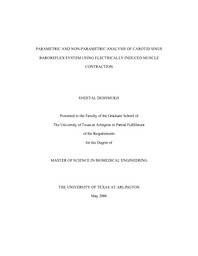
ATTENTION: The works hosted here are being migrated to a new repository that will consolidate resources, improve discoverability, and better show UTA's research impact on the global community. We will update authors as the migration progresses. Please see MavMatrix for more information.
Show simple item record
| dc.contributor.author | Deshmukh, Sheetal D | en_US |
| dc.date.accessioned | 2007-08-23T01:56:09Z | |
| dc.date.available | 2007-08-23T01:56:09Z | |
| dc.date.issued | 2007-08-23T01:56:09Z | |
| dc.date.submitted | December 2005 | en_US |
| dc.identifier.other | DISS-1195 | en_US |
| dc.identifier.uri | http://hdl.handle.net/10106/132 | |
| dc.description.abstract | The arterial pressure is an important physiological parameter which if not maintained at desired level may lead to fatal disorders or in worst situations even death. The physiological feedback control mechanism in order to regulate the arterial pressure is performed by the baroreceptors. In this study the dynamic characteristics of carotid sinus baroreceptor are identified to obtain the open-loop characteristics of the carotid sinus pressure (CSP, mmHg) to the renal sympathetic nerve activity (RSNA, Arbitrary unit), RSNA to systemic arterial pressure (SAP, mmHg), CSP to SAP and CSP to heart rate (HR, bpm).The purpose of this study was to know if resetting of baroreflex resetting takes place during exercise. The assumption that the baroreflex afferents interact with the somatic afferents in NTS affects the baroreflex functioning was evaluated by studying the baroreflex transfer functions for two different measurement conditions.
Data for this study was recorded from 6 dogs for two experimental conditions, control and the electrically induced muscle contraction. The control measurement condition was assumed to be the rest condition and the electrical stimulation mimicked exercise. Non-parametric (NP) estimation technique was applied to the measured data and the baroreflex transfer functions were estimated. The gain and the phase was analyzed in the frequency range of 0.1 to 1Hz. Comparison of CSP-RSNA, RSNA-SAP, CSP- SAP and the CSP -HR transfer functions was made between the electrical stimulation and the control measurement conditions to see if the transfer characteristics differ due to stimulation. It was observed that the DC gain for the two measurement conditions, control and electrical stimulation differed. The slope and the coherence were analyzed in the frequency range of 0.2 to 0.4Hz. Parametric models were estimated employing ARX and OE methods for all four transfer functions, for two measurement conditions to obtain a best possible fit of the model output to the measured output. MSE value from the measured and estimated output was used as the criterion for order selection. Higher order models were estimated along with lower order models. The parametric models were also obtained for the shorter ensembles of the data selected by visual inspection from data of 15 min. Comparison of the nonparametric estimated transfer function and the parametric estimated transfer function was made. The parameters estimated from the control data and the electrical stimulation data were compared for each transfer function by their pole-zero positions.
It is seen that the models obtained from the basic linear model structures doesn't fit well to the measured output. The stationarity of the data and the linearity of the system analyzed is an important issue in parametric modeling | en_US |
| dc.description.sponsorship | Behbehani, Khosrow | en_US |
| dc.language.iso | EN | en_US |
| dc.publisher | Biomedical Engineering | en_US |
| dc.title | Parametric And Non-parametric Analysis Of Carotid Sinus Baroreflex System Using Electrically Induced Muscle Contraction | en_US |
| dc.type | M.S. | en_US |
| dc.contributor.committeeChair | Behbehani, Khosrow | en_US |
| dc.degree.department | Biomedical Engineering | en_US |
| dc.degree.discipline | Biomedical Engineering | en_US |
| dc.degree.grantor | University of Texas at Arlington | en_US |
| dc.degree.level | masters | en_US |
| dc.degree.name | M.S. | en_US |
| dc.identifier.externalLink | https://www.uta.edu/ra/real/editprofile.php?onlyview=1&pid=7 | |
| dc.identifier.externalLinkDescription | Link to Research Profiles | |
Files in this item
- Name:
- umi-uta-1195.pdf
- Size:
- 1.479Mb
- Format:
- PDF
This item appears in the following Collection(s)
Show simple item record


